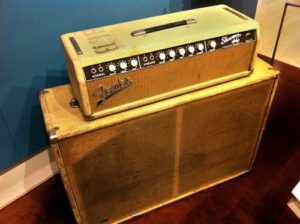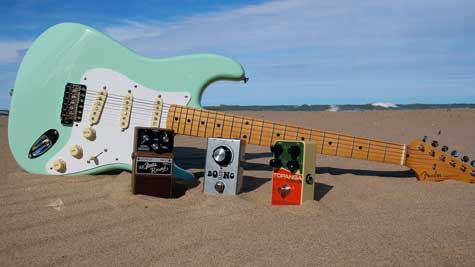Dick Dale is the undisputed founder and King of Surf Guitar. While many know his name, they may not know much about his interesting past and contribution to the world of guitar in general. This includes several innovations of amplification and a personal playing style that changed how many thought to manipulate the instrument. Here at zZounds, it was another easy choice to include him on our Legends of Tone series, as he has quite an interesting story to tell. So interesting in fact, that I am only scratching the surface of this man’s strange and complex life.
Born Richard Monsour in 1937 to his Lebanese father and Polish mother, Dale was exposed to the regional folk music that his parents knew and loved, which eventually influenced his own sense of melody and playing style. In fact, Dale is considered one of the earliest musicians to incorporate more exotic Middle Eastern and Eastern European scales into American pop music.
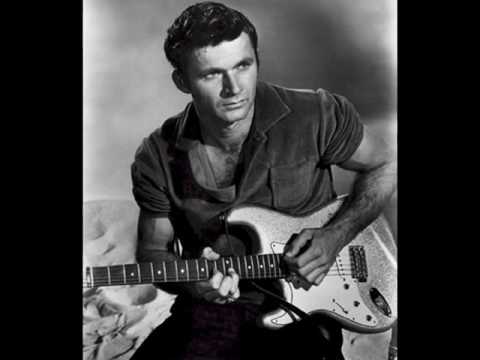
a young Dick Dale
Dale was also a self-taught musician, which no doubt further allowed him to create a highly personal blend of music. To add to his legendary status, many are unaware of just how important Dick Dale was in helping to drive the innovation of the designs of Fender guitar amplification.
Dale’s family moved to Southern California in 1954, where he took up surfing amid the local burgeoning scene at the time. Little did he know that the waves would have more of an effect on his future than he realized. Dale wanted to capture the surging sounds of the waves and the feelings he got on his guitar. This, coupled with his love of famous jazz drummer Gene Krupa, led Dale to develop the thunderous tremolo picking technique that he is so revered for.
Dale’s backing band, the Del-Tones, played regular gigs at the Rendezvous Ballroom near Newport Beach and he quickly gained attention with his fiery and stylized new guitar sound. Once word spread, they were playing regularly and packing the house with thousands of attendees per show. Dale was a local star at this point, and for good reason: he ripped!
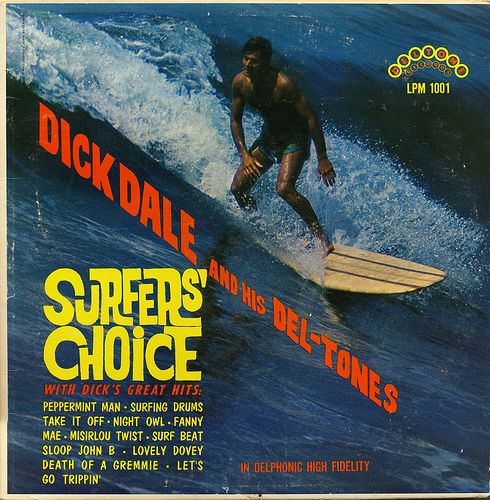
the Del-Tones classic 1962 album
In September of 1961, the Del-Tones released “Let’s Go Trippin’,” which is regarded as the first recorded surf instrumental. The next year they released their seminal album Surfer’s Choice which sold well locally. After this point, they got picked up on Capitol Records and got that album nationally distributed. Notably, Dale was featured in Life magazine in 1963 which solidified his place in the music world. He then landed a spot on The Ed Sullivan Show as well as the film Beach Party, which further spread his music out to larger and larger audiences.
Innovating Amplifier Design
Dale continued to record and release four more albums for Capitol Records through 1965, including King of the Surf Guitar, the follow-up to Surfer’s Choice. It was during this time period that Dale developed a very close working relationship with Leo Fender, which proved to be incredibly fruitful for both parties. Dale had came to Leo because he kept encountering a big problem: his amps would routinely be destroyed by the abuse he would put upon them live, often blowing transformers, busting speakers, or having amps occasionally outright go up in flames.
He needed more power, and Leo Fender was up for the task of making it happen. It didn’t start out so easy though. It is said that Fender was hesitant to significantly increase the power and output of his amps, finding it unnecessary. One night however, he attended one of the Del-Tones’ famed shows at the Rendezvous Ballroom and immediately realized what kind of amp Dale really needed.
Leo Fender would say, ‘Dick, why do you have to play so loud?’
He set to work designing an 85-watt transformer to accommodate the huge amount of volume Dale required. This created one major problem: now he needed a larger speaker that would be able to handle the higher volumes without burning up or breaking down. Fender approached James B. Lansing (of the JBL company) and asked for a larger 15″ speaker, which they agreed to make. This would later become the JBL-D130 speaker. Once the larger speaker was placed into the new amp with the 85-watt transformer, Fender decided to name the amp the Fender Showman (sometimes referred to as the Single Showman) since he admired Dale’s showmanship.
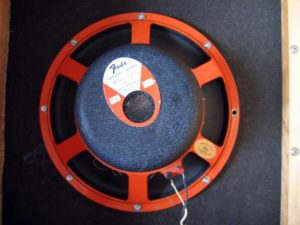
custom JBL D-130F speaker
Once Dale was gigging with the Single Showman amp, he still encountered problems with his speaker cones twisting and becoming damaged from the fluctuations back and forth inside of the amp. Fender once again approached JBL to ask them to redesign the JBL-D130 speaker with a rubberized front ridge to allow the speaker to move back and forth without incurring any damage. This new speaker was called the JBL-D130F with the “F” being an homage to Fender. Happy with this design, Dale continued to play the amp until he once again felt his tone needed to be thicker and louder to accommodate the still growing crowd sizes.
Fender designed a speaker cabinet that could house 2 JBL-D130F speakers to satisfy Dale. In true comedic fashion though, the extra speaker forced Fender to design an even larger transformer to satisfy the speaker combination. They approached the Triad Company and had them design a 100-watt transformer they named none other than the Dick Dale Transformer.
Because of this higher output design and dual speaker orientation, they named it the Dual Showman, a highly revered and classic Fender amplifier. Nothing had ever been done like this in guitar amplification history and it changed the game completely. Because of this, many credit Dick Dale as being the “Father of Heavy Metal” for breaking the volume barriers never before surpassed in the world of guitar.
As if that wasn’t enough, Dale is also credited for implementing the now synonymous reverb tanks we all know and love. As the story goes, Dale was unhappy with his vocals when performing live because he was not a strong singer and lacked the control to execute tasteful vibrato. He had found an old Hammond reverb unit and approached Leo Fender again to help him make one that he could use for his vocals. Once he experimented with the reverb tank, Dale eventually plugged his Fender Stratocaster into it and that was it – what a tone! Reverb would forever be associated with the classic surf sound from that point forward.
Turbulent Times
Surf music was catching on in the mainstream with groups like the Beach Boys and Jan and Dean offering up their takes on the style. But as fast as surf came up, it started to come down. In 1964, the British Invasion stole a lot of interest away from the surf music of the time, causing a drop in Dale’s album sales. He ultimately was dropped from his major label deal with Capitol Records in 1965.
To make matters even worse, he was eventually diagnosed with rectal cancer in 1966 forcing him to stop playing music for several years. The news of Dick Dale potentially having a fatal case of cancer caused players like Jimi Hendrix to famously declare, “Then you’ll never hear surf music again.” Dale went down to 98 pounds in weight after a major surgery and was forced to step out of the limelight. Much later in 1979, he almost nearly lost his leg after he injured it in polluted waters, causing the injury to become so severe that an amputation was considered. Dale suffered from waves of depression, but eventually turned to martial arts and Eastern philosophy to inspire him to get back on his feet and once again return to playing music.
In the ’80s, he was performing in the Reno/Vegas circuit and was lucky enough to score a cameo in the film Back to the Beach, where he earned a Grammy nomination alongside fellow guitar legend Stevie Ray Vaughan for performing the classic 1963 Chantays hit “Pipeline.” This catapulted Dale back to success and enabled him to once again perform music more regularly. He enjoyed moderate success until a pivotal moment happened: the 1994 cult classic film Pulp Fiction was released. Director Quentin Tarantino chose Dale’s classic cover “Misirlou” as the title song for the movie and it became a trademark of the film, driving tons of fans both new and old back to Dick Dale and his music. Dale released the album Tribal Thunder and took advantage of his newfound popularity and appeal. He recorded another album in 2001, Spatial Distortion, and continued to tour. Because of his surge in popularity, Dale had countless commercials, movies, and television shows use his music until well into the early 2000s.
The Gear
As mentioned earlier in this post, Dick Dale was a longtime Fender user, both in his choice of amplifiers and guitars. Once Leo Fender invented the Stratocaster, Dale was quick to adopt and use it for his own music. He was left-handed however, and first was using right-handed models played upside-down until he switched over to left-handed models. Dale chose to not restring the guitars with a typical lefty orientation, instead choosing to play with his low E at the bottom and his high E string nearest him (when looking down at the guitar). He also used extremely thick gauge strings, running high to low at 16, 18, 20, 38, 48, 58.
From there, Dale ran his Strat into the Dual Showman head with the custom 2×15 Fender cabinet discussed earlier. Most often, he runs two Dual Showmans through two 2×15 cabs though for more power and volume. Dale also chooses to suspend his Fender Reverb tank from the rafters when playing to avoid resonance issues (though many times he does not do this live too). He has a pretty simple setup – his only main consideration is volume and power and he doesn’t need any effects pedals to perform his music. It’s a simple plug-and-play rig.
What We Used
For our demo video, we chose a similar setup to showcase how you can still achieve Dick Dale tone without the need to buy a double stack Dual Showman rig, reverb tank, and modify your cabs. We chose a Fender ’50s Stratocaster played through a Fender ’68 Custom Vibrolux amplifier rated at 40W, which proved more than enough for getting those nice and hairy driven amp tones Dale is famous for. We cranked the amp and got to work recording “Misirlou” — easily his most famous cover song. The song was a traditional folk song believed to have originated in the Eastern Mediterranean region.
While the driven amp sound was a big part of Dale’s tone, we needed to find a way to achieve his reverb sounds too. Naturally, we chose to start off the video using the on-board reverb in the Fender Vibrolux because it simply sounds great. But after that, we experimented with several pedals to achieve different flavors of reverb tone. First up was the Boss ’63 Fender Reverb, which was incredible for achieving those wet and in-your-face swampy reverb sounds often heard on surf recordings. For reference, we engaged this unit for the reprise of the melody after it jumps up an octave. After this, we moved on to the J. Rockett Boing that is perfect for spring reverb sounds (makes sense). We engaged it during the solo guitar portion after the bridge. Finally, for the final reprise of the melody we used the Catalinbread Topanga. This excellent pedal was easily the wettest sounding unit of the ones we used. It has a highly resonant sound that can be adjusted with high degrees of sensitivity. This made our final melody really pop out with a lot of depth. Check out the video at the top of the page to hear for yourself!
The Legend Continues
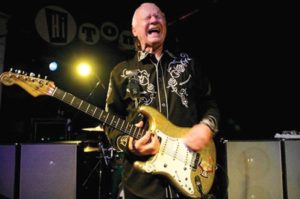
Dick Dale still going strong
All in all, this was a really fun video to be a part of because it offers a true snapshot of a bygone era of music history. Surf music is still around and kicking, but it must have truly been a life-changing experience getting to hear and feel those sounds in the ’50s and ’60s up-close and personal. Our video was meant to be as accurate a representation of one of the old recordings of “Misirlou,” even down to the exact picking patterns Dale used with his right hand.
Dick Dale is about to turn 80 years old in a few weeks, and he’s still going out, touring, and making it all happen. Though he may not be in the best of health, he is confident that he will be playing until he can play no more, and we commend him for it. He was such a pivotal part of helping to design amplifiers for louder applications, more interesting speaker combinations, and even having a hand in implementing reverb tanks in amplifiers. Without his creative additions to the world of music and guitar, we may not have ended up where we are now. Dick Dale is truly a guitar legend, and will forever be cemented in guitar history.

